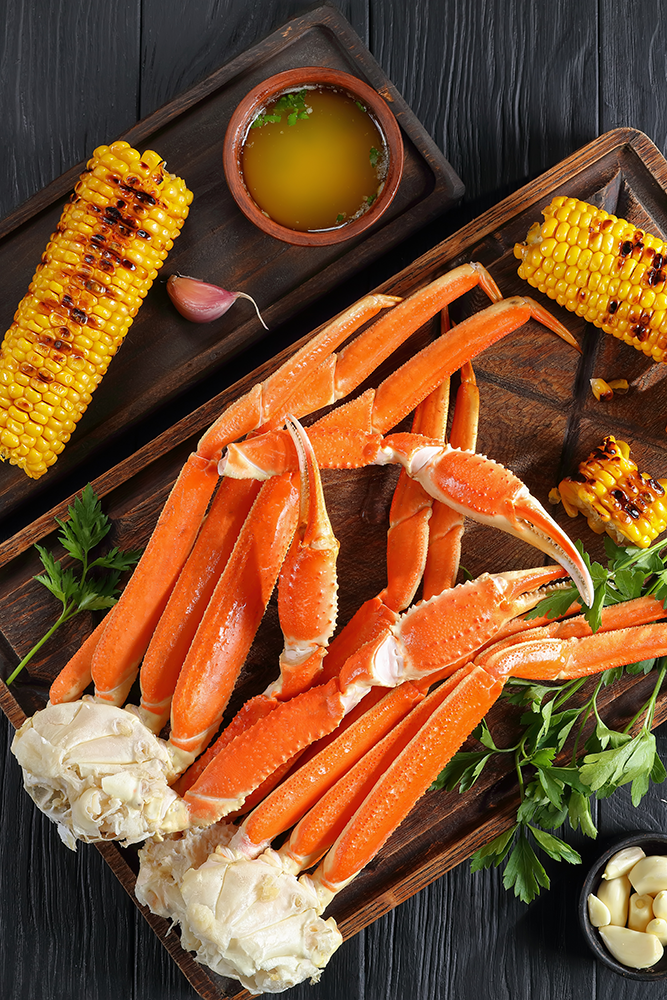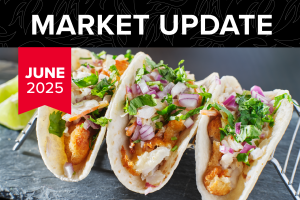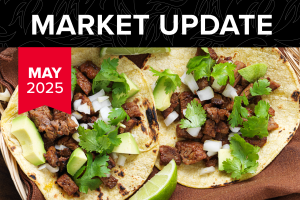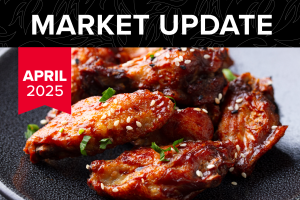Your monthly update on the state of the pork, poultry, beef, and seafood industries, direct from the category experts at Y. Hata.
Grocery
Thanksgiving: Due to shortages caused by the avian flu, and overwhelming demand on turkey, Turkey Breast Roast is in very limited supply. The supply of breast/thigh roast 60/40 is available for restaurants who have not yet ordered their turkeys for the Thanksgiving season.
Logistics Update: All Three Coasts have seen a decline in imports (West, East and Gulf) for the month of September. Overall, US imports for the summer months were still at record highs. Congestion on the West Coast forced many shippers to shift cargos eastward partly due to fear of West Coast peak season and labor unrest (contract disputes). All signs point to a continuing increase for the East and Gulf Coast. There was a short-term decline due to Hurricane Ian which caused the suspension of service for roughly 3 days. Those volumes will be reflected in October.
Potato – The prospect on yields across early varieties of potatoes are down. Delayed planting and cool start to the season has projected yields down 8-12% in the Pacific Northwest. Farmers are optimistic though as maturing varieties are exhibiting good quality to offset lower yields.
Sweet Corn – Corn yields on planted acres are looking healthy with good quality overall. Total planted acres are down due to competition from other crops. Strong yields are not expected to offset the missing volume due to reduced acres. Corn supply will likely be tight again out of the Pacific Northwest.

Poultry
The HPAI bird flu continues to weigh heavily over the poultry industry as more than 47 million birds have been culled or died from being infected. Unlike the last major outbreak in 2015 the persistence of this virus has many farmers worried that we will likely face an elevated level of infections until summer 2023 as wild birds migrate throughout the country.
Overall, there is a negative sentiment in the poultry market as demand for all chicken parts remain lukewarm. With both retailers and foodservice distributors remaining price sensitive and inventory stockpiling in cold storage facilities we are seeing softness in the market as prices decrease weekly.
- Bone-In Thighs: Demand for Bone-In Thighs has dampened quite a bit as we are finally seeing lower pricing. Despite this decreased demand we are still not seeing widespread availability as any offerings are still limited to only a handful of packers.
- Boneless Skinless Thigh: Boneless Skinless Thigh prices continue to decrease weekly as buyers remain reluctant to commit to more than what they need.
- Leg Meat: Leg Meat prices have also been decreasing as packers are under pressure to move mounting inventory due to tepid demand.
- Breast Meat: Breast Meat prices continue to experience a downward price correction as we are still at elevated levels compared to prices in past years.
- Wings: Wing prices have remained at historically low levels as seasonal demand for bone-in wings has not materialized yet even being over a month into the football seasons. For the time being, both retailers and wing centric national chains have yet to step in even with wings at low price levels.
- Turkey: Turkey farmers have been severely impacted by the recent spike in HPAI outbreaks across the country. With Thanksgiving approaching next month, there is poor availability for any whole turkeys or turkey roasts. Whatever limited offerings being uncovered at this point are at record prices more than double pre-COVID.
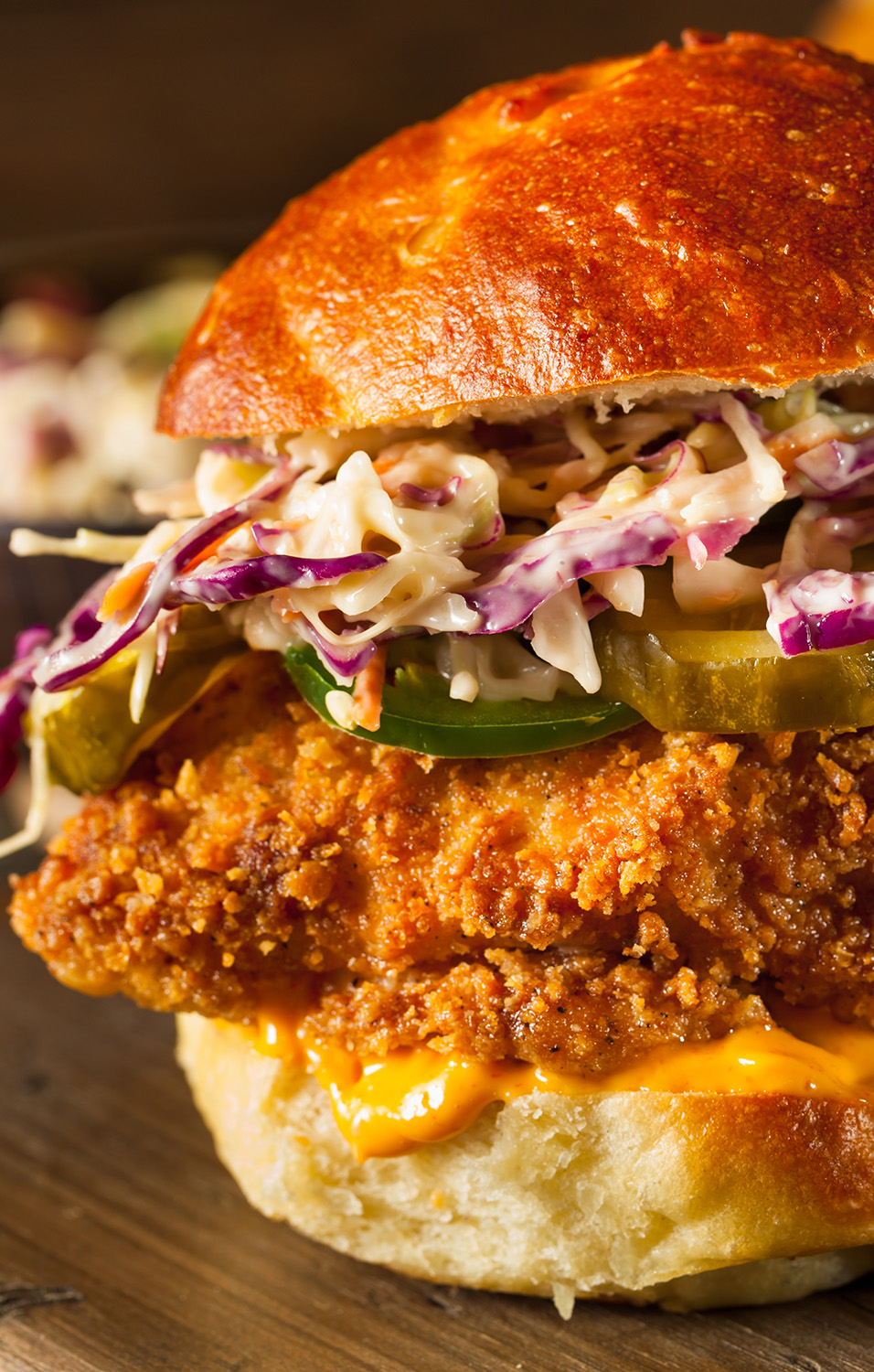
Pork
Hog farmers have been reducing the size of their herds in the face of rising input costs for fuel, fertilizer, and feed leading to reduced supply and increased prices that pork companies are having to pay for hogs. As was widely expected by many in the pork industry, these higher prices have resulted in weakened consumer demand.
Another issue looming over the pork industry is the uncertainty regarding California’s Proposition 12 legislation. The Prop 12 law mandates minimum housing space requirements for breeding pigs, veal calves, and egg-laying hens. Although California represents roughly 15% of the U.S. pork market making them a relatively small pork producing state, the law is still expected to significantly affect out-of-state hog producers.
Since last month’s meeting both the National Pork Producer’s Council (NPPC) and American Farm Bureau Federation (AFBF) presented their case to the U.S. Supreme Court on October 11th requesting for California’s Proposition 12 to be overturned. As of this week the Supreme Court has not rendered a decision so the pork industry will continue to monitor the outcome of this case.
- Boneless Butts & Ribs – Both Boneless butt and rib prices have been steadily decreasing weekly in the face of inflationary pressure with consumers spending less on proteins and reduced export volume to China. Despite softness in the market, both packers and buyers continue to take a “wait and see” approach.
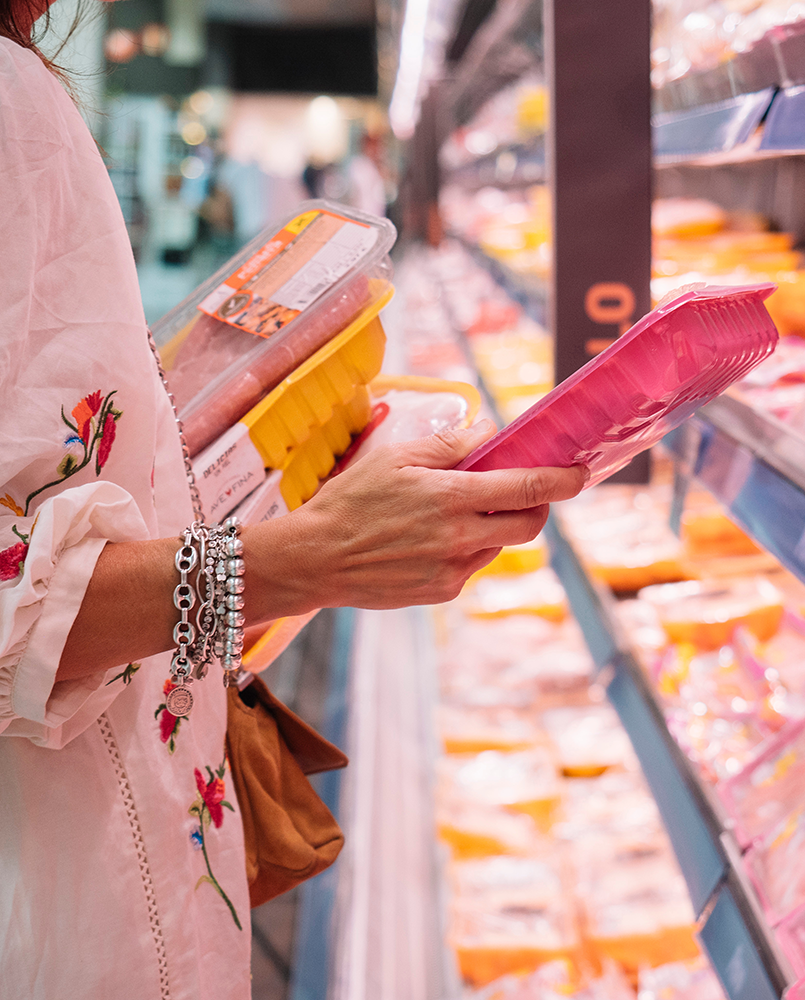
Pork & Poultry Market Outlook
For the poultry industry we are amid a price correction for almost all chicken parts as there appears to be more downside to prices due to lukewarm consumer demand. For the pork industry prices have returned to more normal levels for the most part although we are seeing occasional choppiness in the market. With lingering inflationary pressure on the economy and a potential recession looming, both consumers and suppliers are taking a cautious approach.
Beef
Rising costs for fuel, feed, fertilizer, and labor continue to impact cattle ranchers. With these elevated costs, beef packers are having to pay more for live cattle which is contributing to higher beef prices.
Despite persistent inflation, higher beef prices continue to be supported by tighter cattle supplies and steady consumer demand.
Additionally, widespread drought conditions continue to impact many parts of the country significantly impacted grading for choice, prime, and premium grades (CAB, SS, & PSA). Prime beef in particular remains at historical high price levels due to poor availability of prime grade cattle and prices are expected to persist through the remainder of 2022.
All major beef packers expect to incur additional supply issues at some point in the future, perhaps as soon as the end of 2022. Beyond this year, it is a matter of when not if we see significantly less cattle available in the future. Despite reduced availability, demand continues to remain strong for prime and premium grades (CAB, SS, PSA) regardless of cut.
- Ribeye pricing has been sluggish of late which is primarily due to consumer hesitance with purchasing higher priced middle meats amidst diminished income to spend on groceries. However, ribeye prices have started to trend upwards as we approach the holidays when demand is expected to increase as people get together for family gatherings both at home and in restaurants.
- Striploin pricing, which decreased substantially over the past 2 months, is nearing pre-COVID price levels. With retailers featuring ground beef and end cuts such as chuck items more prominently in their ads, striploins are a great value right now.
- Chuck flat pricing which recently decreased by $.44/lbs. this month will unfortunately be increasing by $.61/lbs. for November. This increase is primarily due to the higher cost of cattle that packers are paying as well as the projected shortfall of premium grade beef (CAB, SS, Prime).
- Oxtail pricing, which had been on decline during the summer, will be increasing by $.42/lbs. later this month.
- Short rib pricing is steady for now but is poised to increase further as we approach the end of the year primarily due to younger cattle being harvested and diminished grading affecting the supply of raw material.
As we approach the holiday months, the prevailing sentiment for the beef industry is uncertainty. With inflation continuing to impact consumer spending there are strong indications that the beef industry may be looking to cut back kills at their plants amidst soft consumer demand further tightening the supply of beef.

Seafood
- Snow Alaskan Red King and Snow Crab – The Alaska Department of Fish and Game (ADF&G) has completed their surveys of both fisheries. The stock levels are estimated to be below ADF&G threshold for opening the fisheries. Therefore, the 2022/23 season will remain closed for both fisheries. Scientists have no answers to where the crabs are or why they haven’t returned to their normal grounds on the US side of the Bering Sea. Some say it’s due to Global Warming, but no definite answer has been given. This is the 2nd consecutive annual closure for Red King Crab and the FIRST EVER closure for Opilio Snow Crab. There is a Gold King Crab Season and a small Bairdai Season ongoing.
- N-Atlantic Lobster Tails (Cold Water) – The upcoming season is set to open the last Monday in November and run through the winter. Historically, this is when the larger lobsters are caught. Recently Hurricane Fiona affected parts of Canadian Atlantic and did some damage to boats and processing plants, but they should be repaired in time for the new season. The fishing zones that were affected will have plenty of time to recover as most have completed fishing for the 2022 season.
- Tuna – Poke Cubes are in plentiful supply with containers inbound in November and the middle of December.
- Vanamei White Shrimp – Consumer demand is slowing due to inflationary pressures, and suppliers have inventories accumulating. They need to move product to improve their cash flow and create space in cold storage facilities for containers that are in transit. Suppliers are motivated to move product.
